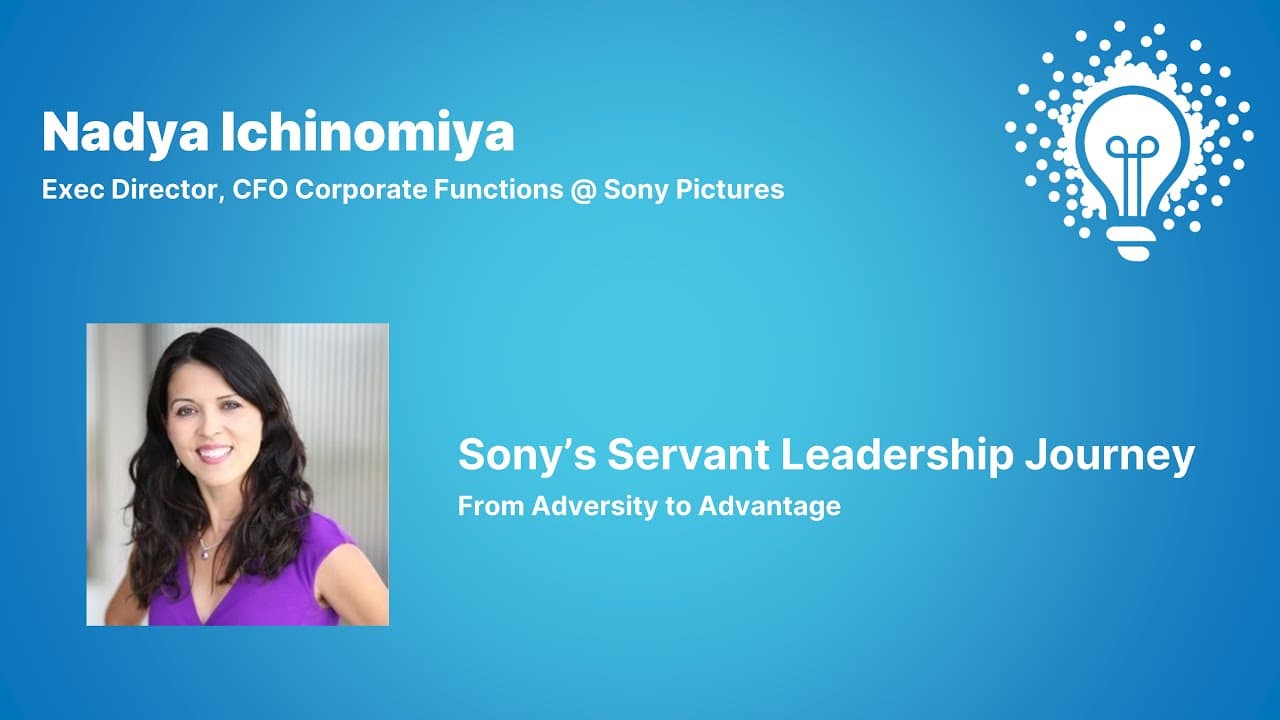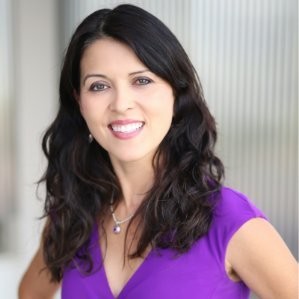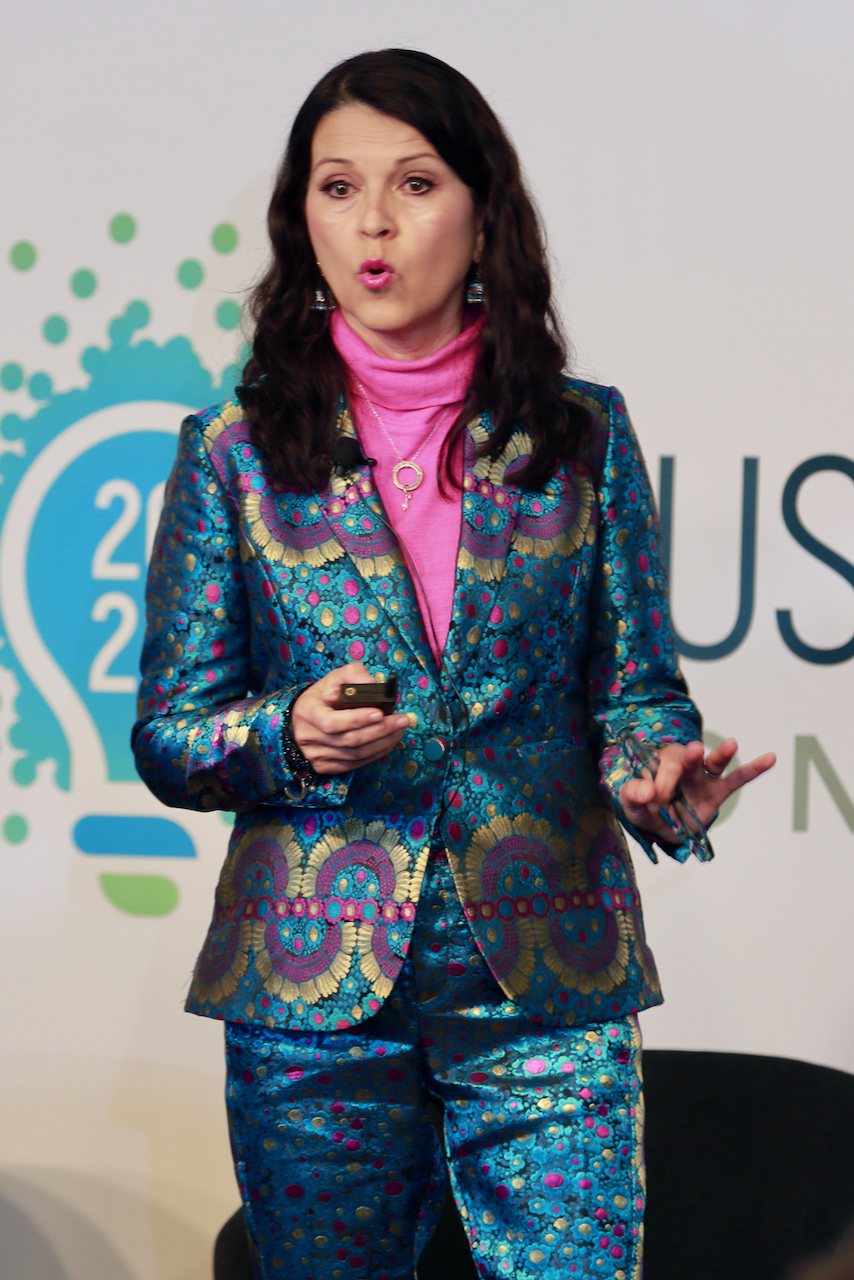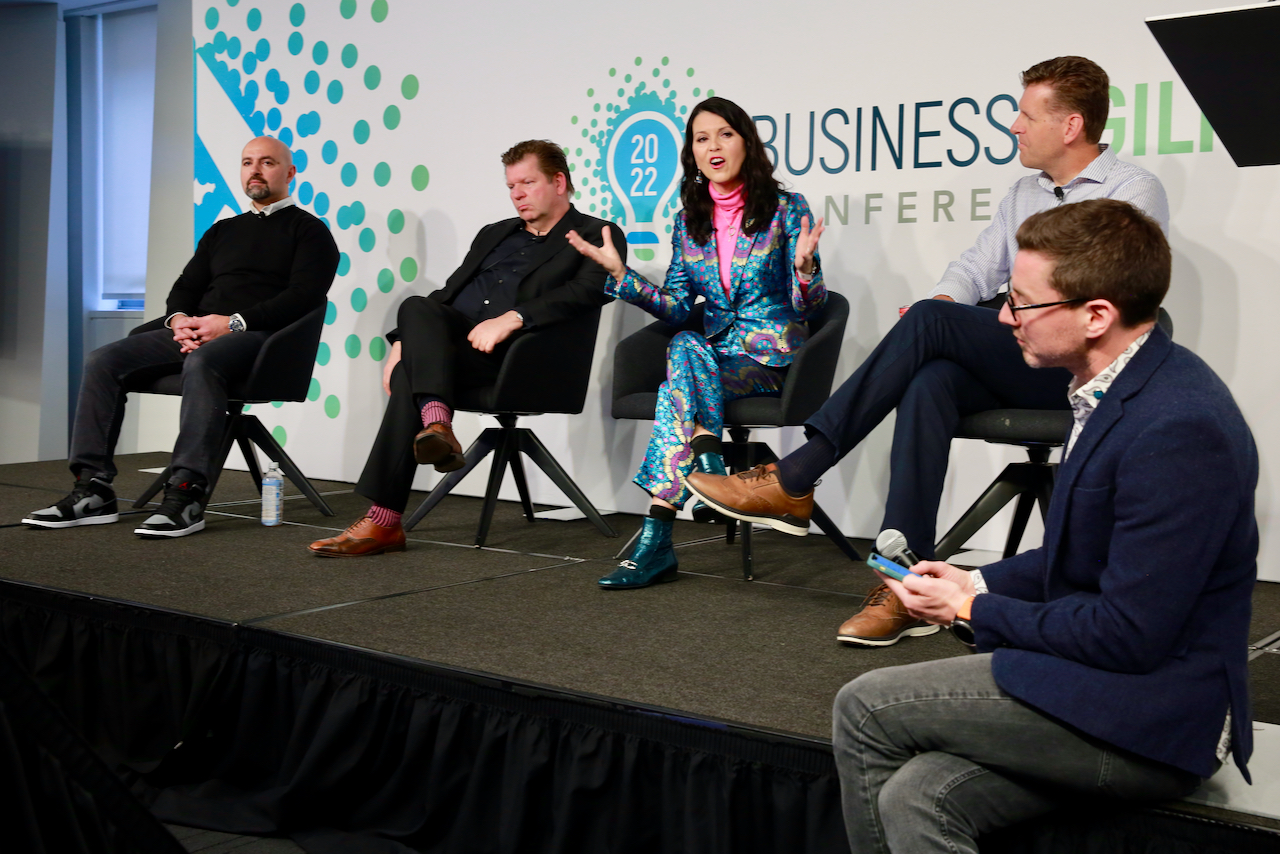Hello, Business Agility Conference.
My name is Nadya Ichinomiya, and I head up the Agile Center of Excellence for Sony Pictures Entertainment, and I'm delighted to share our Business Agility Journey and our Servant Leadership Journey with you. But before that, a bit about the company itself.
Sony Pictures lights up screens around the world with movies like Spiderman, Jumanji, Venom, and Ghostbusters, and TV shows like The Blacklist, Outlander, Crown, and Cobra Kai. We have $10 billion in revenue and 9000 employees.
I'd like to share with you a typical story about an employee who participated in our program. Darren Hopgood had hit the wall at work. It was a perfect storm of transformation projects on his plate, and he couldn't get to all the people he needed to. He had a liberating conversation with his manager, Bill, who told him, it's okay not to get all of this right. Darren, it doesn't have to be perfect. You can approach things differently.
Darren stepped away from the project, handing it over to three people on his team who welcomed the growth opportunity. Since these were stretch initiatives for all three, he had the similar liberating conversation that Bill had with him that it was okay not to get all of it right.
Right now, Darren had the space to focus on strategy and make an impact. This is an example of the benefits of the Servant Leadership Program.
But I got to be honest, it's not how it started out.
Started out with a big challenge. Many of you may have seen the David Marquet video where he relates how he spent a year training to captain one nuclear submarine, but suddenly found himself the captain of a vastly different one. He unknowingly gave an impossible order which his crew tried to implement. The traditional command and control model of leading would have been deadly. So Captain Marquet had to invent a new model of leading, which he calls Intent-Based Leadership. The video is very inspiring, and our CFO, Philip Rowley sent it out.
People loved it and there was no behavior change. He sent it out again. People were inspired and there was no behavior change. In fact, the video was part of a course I'd been teaching since 2019. The course got great scores, but I'll be honest, I didn't notice much behavioral change.
Just reflect for a moment. How many times have you taken a course, been inspired, and then you get back to your work, and you get engulfed with a snowstorm of stuff coming at you and the inspiration becomes a beautiful but distant memory.
I gave this challenge a lot of thought and I realized the course was like a bit about like getting into shape. You take a two hour course, but even if you're lifting weights the entire time, there's still no way you're going to get into great shape. So the looming question was; how can we support people in operationalizing the training, so when they get back to their jobs and are facing everyday leadership challenges on the court? And we had to do it at scale.
As you can see, I'm just one person. Essentially, I needed to create a movement. So I got inspired by three things. The first one was this. In the area of learning and development, there's a concept called the Learning Pyramid. Some of you may be familiar with this already.
The point is to drive up knowledge retention by using learning approaches further down the pyramid. Notice here discussion group "practice by doing and teach others" take retention to 90% since they're active teaching methods while just a lecture through demonstration approaches through the top of the pyramid only take retention rates to 50% because they're passive teaching methods.
I realized that in order for people to truly get servant leadership, I had to push the learning to deeper levels. So I decided to create a framework for peer coaching and mentoring in order to get to the 90% level for learning retention. This led to the creation of our Circles program. More on that later.
The second thing that I kept in mind was in order to produce culture change, I needed to intentionally use the law of diffusion of innovation, how ideas spread and go viral. There's a great book, Crossing the Chasm by Jeffrey who discusses this, and a ten-minute YouTube video by Simon Sinek that you should watch called How to Make a Cultural Transformation. They're both great. We needed to unleash the passion and enthusiasm of early adopters, which would pick up enough momentum to cross the chasm and persuade the early majority.
And the third thing that inspired me was an article I stumbled on from BBC.com called the 3.5% Rule: How a Small Minority can Change the World. The quote that stuck out is nonviolent protests are twice as likely to succeed as armed conflicts, and those engaging a threshold of 3.5% of the population have never failed to bring about change.
This really stuck with me that 3.5% of a population is needed to bring around culture change. Three 5% of a company of 9000 is 315 people. So that became my stretch-for-amazing goal for the follow-on Circles program, reflecting the three 5% of a population needed to create change.
After the first two sessions of the two-hour course in July 2020, I asked the participants via a survey about a follow on program and 30% of my students signed up. The pressure was on. In the circles program, four to six graduates of the training course meet once every one to two weeks for 30 minutes or an hour to work on specific skill sets.
Rob Patton and Jason Spaltro are heads of their respective departments. Their working relationship had always been professional. However, in being in the circle together for many months, Working on missions and having their weekly circles be a safe space, they found that it also spilled into their work outside the circle program. Melting the silos between them and making their collaboration more human, more effective, and more fun.
Another example of how business agility was taking root throughout the servant leadership program. There were a lot of experiments in creating the circle program, but there were some inviolate principles that I stood by from the start.
Key guiding principle one, make it inclusive, not exclusive. One of the key guiding principles I stuck to was making the servant leadership program available to all employees, contractors and individual contributors, not just people who have the official leader title. This is because I feel strongly that everyone can be an architect of our culture and what we're attempting to do with this movement was to create a tidal wave of culture change.
In fact, in the early sessions, I discussed the diffusion of innovation model where innovators and early adopters equal 16% of the total. And this culture change would only be possible if we can amass those 16% and move into early majority-land and push the movement to be the de-facto culture of the company. And we needed them to spread the word. Get their colleagues to take the course and be part of the movement as well.
I wanted to be very mindful that the servant leadership program, for it to have integrity and be congruent with the foundational elements of servant leadership, it would need to grow organically. People would volunteer to be in the program, not be voluntold to be in it. After all, it would be very hypocritical and command and control for it to be mandatory or heavy handed in any way.
So in the same vein, I decided that the circle program would also be available to all people, including individual contributors. This is quite different from mostly leadership programs which tend to be focused on people with direct reports and positional authority. This was much more than mere leadership training. I wanted to create a grassroots democratic empowerment movement of happy culture warriors, and I needed as many I could get into this volunteer army.
Key Guiding Principle Two: intentionally invite diverse perspectives, experiences, and levels. One of these was the setups of the program itself. I wanted to intentionally dissolve silos, so a typical circle will be made up of four members, one from facilities, one from procurement, one from IT, and someone from finance. I really wanted participants to be in circles with people from different departments.
One of the other inviolate principles was I wanted people of different levels to be in the same circle together. Someone actually advised me against this, saying that they thought the more senior leaders wouldn't want to be in the same circles as junior people. They might feel more comfortable with their peers, or they wouldn't learn as much from junior people. As someone who has benefited incredibly from reverse mentorship, I just didn't agree with this. To me, the idea of people only with their peers went against the entire spirit of the program, which is about empowerment, and that the talent and brains of the company are not concentrated in the C-suite.
Once I've done the matchmaking of setting people up in their circles of four to six people. I sent emails to each of the circles with their mission, a list of assignments for them to tackle. Our first cohort had 28 people. So there were seven circles with four people to each circle. The missions are intended to be implemented with people's existing teams, and colleagues, not their circle.
One of the things I was super mindful of is people's bandwidth and time constraints. Many people have some variance in their schedules. Their workload tends to go up and down depending on movie release dates, year end close, month end close, project timelines, et cetera. I was inspired by how cloud service providers make cloud bursting available so usage can flex to the demand cycles of their customers. So I deliberately designed the missions with maximum flexibility so people could scale up or down their engagement across the duration of the program.
Each mission starts off with a mandatory assignment and then three to seven so called bonus assignments. Assignment examples are implementing an experiment with your team, reading a Harvard Business Review article, working through a workbook exercise on your own, journaling, watching a Ted Talk, or other videos on YouTube from Servant Leadership thought leaders. I knew we'd have a myriad of communication styles, so introverts might prefer to answer questions in a workbook or journal on their own.
We also had a significant percentage of individual contributors, so the program would need to flex to their needs. I wanted to make each circle a self organizing team. They're asked to pick a circle name, and circle leader, which, in alignment with the principles of the program, didn't need to be the most senior leader. I encourage circles to leave their titles at the door. I felt that the circles should pick their own meeting cadence, so some people meet once a week, while others meet every two weeks.
One of the objectives of the circle is to create a safe space for participants to discuss what they're dealing with and to debrief with each other on how the missions are going. Many circles set up a chat channel where they could provide support for each other, discuss the wins, and provide peer coaching and compassion and empathy when things weren't going as well as people would hope. The structures of accountability were also present in the circle because people wanted to keep up with their missions and not let their circle team down.
One of the strategic keys to the program is the bonding that happened in all the circles. So getting that first meeting set up was key, so participants could get to know each other and start working together so that bonding would happen. People are far less likely to drop out of the program when they bonded with their circle mates. Some circles have even bonded so well that they're still meeting monthly to check in long after they completed the circle program.
Back to our story.
After Mission One, I sent out a survey. We got great response rate and people were really enthusiastic about the program. They did feel that two weeks I'd given permission was too short, so I changed it to three weeks. This was also around the time that a new milestone happened. The program went from my program to our program.
One of my colleagues, Susan Black, volunteered to help us coprogram, lead and others in Cohort One wanted to jump in to help this movement become a momentum. Something bubbled up from this group of highly engaged people that developed into the Circle Coaches Initiative. Another idea that came out of Cohort One was the idea of certificates. A PDF that people could print out about their participation, which we give out upon program completion.
In the meantime, I needed to write Mission Two. I'll be honest, these were a heavy lift for me. I care so deeply about this, and I spend a lot of time curating my sources; various books, articles, videos, and creating workbooks. So the materials will be thought provoking and provide a lot of value for the participants.
At the outset, I also didn't know how many missions there would be, so the program is ten months and twelve missions, which in the beginning would have probably shocked the heck out of me. As a time commitment rule of thumb, we recommend 2 hours a month, ten minutes a day, which most people found they were able to do given their existing time commitments and bandwidth.
Overall, we've had very little attrition in the program; about 5% due to maternity, paternity leaves, illnesses, people leaving the company, or bandwidth challenges. I knew I wanted to cover the David Marquet Turn the Ship Around book and also Liz Wiseman's Multipliers: How Great Leaders Make Everyone Smarter. But it was tough for me to estimate how many missions it would take to cover those books, plus materials from other videos and articles that I felt would be useful.
My first soft estimate was six months and six missions, but that wasn't looking like a reality. So I surveyed Cohort One and the vote was to go to the distance, do justice to the material. Versus splitting up the material to an initial program in an advanced course, or cover the material more superficially.
The Circle Coaches, unleashing the volunteer army. One of the key success factors was to leverage the enthusiasm of early adopters, so hence the Circle Coach program was born. We surveyed Cohort One and five people signed up to be Circle Coaches. The role of the Circle Coaches centered around these five areas.
One, support Circle liftoff - set up and facilitate the first Circle meeting so with all the participants answer questions about expectations, handle concerns.
Two, provide support for the two program readouts.
Three, be a sounding board on the Servant Leadership Challenges.
Four, support participants who feel uncertain about the program.
And Five, be a conduit to the program team, letting us know of Circle sentiment, successes, challenges, and requests.
Most of the Circle Coaches are not agile coaches. Some have positional authority, while some are individual contributors. Since this is a leadership role, some of the individual contributors have found the role beneficial for practicing and demonstrating their ability to be a leader. All of them have found the program to be useful in reinforcing the Servant Leadership concepts while giving them an opportunity to practice with their participants as well as increasing their network and visibility by working with people all across the company.
All our volunteers have gotten a lot out of the Circle program themselves and wish to be catalysts for this movement continuing to grow. I hope you've enjoyed this presentation. One thing I haven't mentioned explicitly is the meaning behind the title of this presentation, Sony's Servant Leadership Challenges. Sony's Servant Leadership Journey from Adversity to Advantage. Yes, we started off at a time of apparent adversity in an unprecedented global pandemic. We succeeded not in spite of it, but because of it.
Seemingly overnight, with drastic changes in how people work together, we could look beyond our headquarters in Culver City, California to a digitally collected, connected, and level playing field. Suddenly, the entire world of Sony was open to us and people were hungry to connect with each other in new and meaningful ways. What we offered them was not simply a way to recreate their existing work culture remotely, but to step beyond and invent a new kind of impact they could carry forward in their post pandemic world.
Servant leadership is all about being able to multiply positive impact in ourselves, in those we lead and those we serve. To our surprise and wonder the pandemic became the catalyst that allowed us to multiply the impact of this program. Creating advantage in adversity.
Thank you so much.







